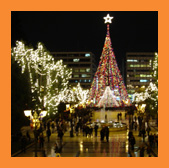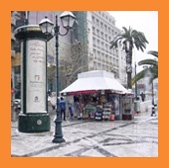



Syntagma Square,
officially Plateia Syntagmatos, or Constitution Square, is perhaps the
emotional home of modern Athens. It is dominated by the imposing facade
of the Parliament building, or Vouli, which was built as the new royal
palace following independence, officially opened in 1836. The use of Pentelic
marble on the facade with a Doric-style prolylaia above street level echoes
use and form in the ancient city. In front of the building, the
Memorial of the Unknown Soldier
commemorates all Greeks who have fallen in war. Decorated with a modern
carved relief of a Classical theme, the marble is inscribed with the words
of an oration by Pericles, to honour the dead of the wars of the Peloponnese.
It is said that the tombs of these ancient soldiers lie under this very
spot. The tomb is guarded day and night by the Evzones, traditionally
dressed soldiers who became Royal Guards, and then presidential guards
following the War of Independence. The formal changing of the guard takes
place every Sunday at I0:45am, however the members of the Evzones have
a duty switch every hour during the day, when two new guards take the
place of the old. This is one activity that you shouldn't miss on your
trip to Athens.
Numerous major thoroughfares converge on Syntagma, so it's always busy
with traffic. The new Metro station also brings a steady stream of people.
Still there is shade and a flower garden in the middle of the square where
locals and visitors alike rendezvous for lunch or dinner dates.
The Grande Bretagne Hotel, on a nearby comer of the square, was built in 1842 and has become an Athens institution during its lifetime.
Behind the Parliament building are the verdant land-scaped
grounds of the National Gardens. These gardens were formerly for exclusive
use of the Royal Palace but now form an oasis within the city with formal
gardens, water features and a children's playground. In the south of the
garden you will find the Zappion Hall, an imposing Neo-Classical building
that was designed by architect Hansen, as a National Exhibition Centre
in 1888. It now houses a modem conference centre.
![]()
A five-minute stroll from Syntagma down Avenue Amalias (or through the
National Gardens) brings you to another ancient site. At the confluence
of Avenues Amalias, Syngrou and Vas. Olgas is Hadrian's Gate, built as
a triumphal arch in AD 131, to mark the divide between the ancient city
and his New Athens. To the east of the gate is the Olympieion, site of
the largest temple ever built on Greek soil.
The Temple of Olympian Zeus is dedicated to Zeus, the king of the Greek gods. It was imperative that his temple should be fitting for his position, and its dimensions, 250 m long and 130 m wide, with columns of over 17 m in height, are truly majestic. The temple took 700 years to complete and it was emperor Hadrian who finished the task in the 2nd century AD. Originally 108 columns surrounded an inner sanctum that protected a gold and ivory statue of Zeus. Today only 15 are still standing, but their Corinthian capitals have a wonderful form and elegance. In ancient times, the temple sat close to the banks of the River Ilissos thus creating an even more beautiful vista. Today the river still flows, but its path lies beneath the city.
Nearby, along Vas.Olgas, is the impressive Panathenean
Stadium, sitting in the lea of Ardhitos Hill. The stadium was constructed
for the ancient Panathenaic Games, when each of the surrounding city-states
sent delegations to compete. During Roman times, beast-baiting also took
place here. Dating from the 3rd century BC, the complex was refurbished
for the games of AD 144 but was disused and left to decay after the fall
of the empire. When the modern Olympic Games were convened in 1896, the
stadium was refurbished as the flagship arena, and today it stands as
a symbol of the global athletic movement. Witness the heroic statues that
stand in the entranceway, Athens hosted the Olympic Games in 2004.
![]()
Lycabettus
To the west of the bare sheer rock of the Akropolis is a rival hill-the
verdant pine-clad Lycabettus, which makes an inviting diversion from the
archaeological sites of the city. Here you'1I be able to sit in the shade
and listen to the birds. The hill was never settled in ancient times because
there was no water supply. You can reach the upper slopes by funicular.
When you reach the top station, walk to the small chapels of Aghios Isidoros
and Aghios Georgios, centre of the Easter celebrations for the city, a
modern amphitheatre for summer performances and wonderful views across
Athens where major attractions are pointed out on marble panoramas. Though
there are fixed telescopes here, having your own binoculars is a boon
to really take in the detail.
Kolonaki
Surrounding the lower slopes of Lycabettus on the south and west sides is Kolonaki, perhaps the most fashionable district of central Athens. Apartments and houses here are much sought after as they sit among chic boutiques, designer stores as well as trendy restaurants and bars. It is one of the best parts of the city to eat out in the evening with a range of good international eateries in addition to traditional Greek tavernas.


